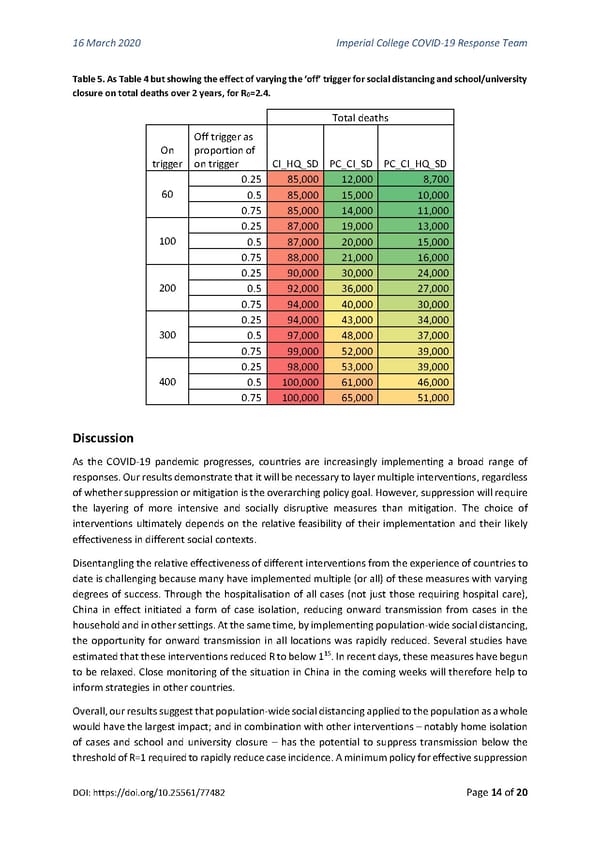16 March 2020 Imperial College COVID-19 Response Team Table 5. As Table 4 but showing the effect of varying the ‘off’ trigger for social distancing and school/university closure on total deaths over 2 years, for R =2.4. 0 Total deaths Off trigger as On proportion of trigger on trigger CI_HQ_SD PC_CI_SD PC_CI_HQ_SD 0.25 85,000 12,000 8,700 60 0.5 85,000 15,000 10,000 0.75 85,000 14,000 11,000 0.25 87,000 19,000 13,000 100 0.5 87,000 20,000 15,000 0.75 88,000 21,000 16,000 0.25 90,000 30,000 24,000 200 0.5 92,000 36,000 27,000 0.75 94,000 40,000 30,000 0.25 94,000 43,000 34,000 300 0.5 97,000 48,000 37,000 0.75 99,000 52,000 39,000 0.25 98,000 53,000 39,000 400 0.5 100,000 61,000 46,000 0.75 100,000 65,000 51,000 Discussion As the COVID-19 pandemic progresses, countries are increasingly implementing a broad range of responses. Our results demonstrate that it will be necessary to layer multiple interventions, regardless of whether suppression or mitigation is the overarching policy goal. However, suppression will require the layering of more intensive and socially disruptive measures than mitigation. The choice of interventions ultimately depends on the relative feasibility of their implementation and their likely effectiveness in different social contexts. Disentangling the relative effectiveness of different interventions from the experience of countries to date is challenging because many have implemented multiple (or all) of these measures with varying degrees of success. Through the hospitalisation of all cases (not just those requiring hospital care), China in effect initiated a form of case isolation, reducing onward transmission from cases in the household and in other settings. At the same time, by implementing population-wide social distancing, the opportunity for onward transmission in all locations was rapidly reduced. Several studies have estimated that these interventions reduced R to below 115. In recent days, these measures have begun to be relaxed. Close monitoring of the situation in China in the coming weeks will therefore help to inform strategies in other countries. Overall, our results suggest that population-wide social distancing applied to the population as a whole would have the largest impact; and in combination with other interventions – notably home isolation of cases and school and university closure – has the potential to suppress transmission below the threshold of R=1 required to rapidly reduce case incidence. A minimum policy for effective suppression DOI: https://doi.org/10.25561/77482 Page 14 of 20
 Non-Pharmaceutical Interventions to reduce COVID-19 mortality and healthcare demand Page 13 Page 15
Non-Pharmaceutical Interventions to reduce COVID-19 mortality and healthcare demand Page 13 Page 15